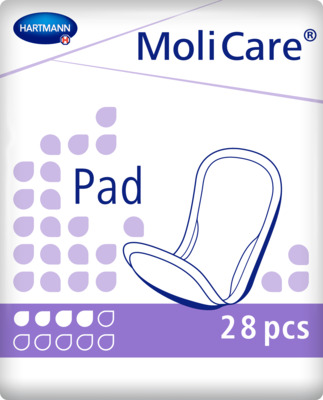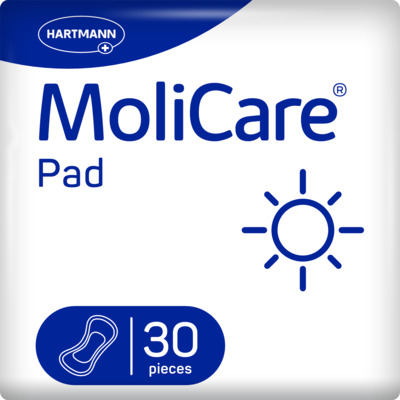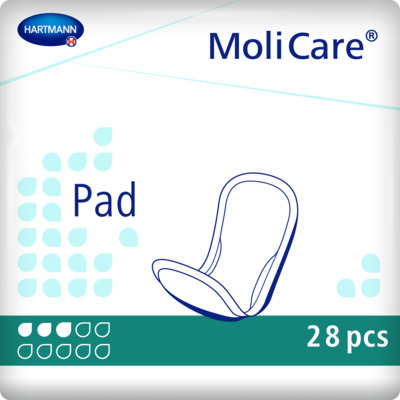Incontinence Advice
Dealing with shy bladder syndrome (paruresis)
Breaking the silence: Understanding shy bladder syndrome and how to overcome it. We have a wide selection of incontinence pads that you can use to help you manage this syndrome.

Dealing with shy bladder syndrome can be embarrassing but understanding the condition and taking steps to treat it will help you handle the symptoms and move on.
What Is Shy Bladder Syndrome?
Shy bladder syndrome is a condition where someone is unable to, or afraid to, urinate in the presence of other people, whether they are actually there or maybe just conscious that people could be there. Consequently, the person experiences serious anxiety when using public toilets. It may also be called paruresis, bashful bladder, or pee shy, although the medical description is Psychogenic Urinary Retention.
Officially, shy bladder syndrome is recognised as a social anxiety disorder instead of a social phobia, and it can affect men and women of any age and background. As a result of shy bladder syndrome, people may withdraw into themselves, avoiding travelling, socialising, and sometimes even working. Fortunately, shy bladder syndrome is highly treatable.
What Are the Symptoms of Shy Bladder Syndrome?
Symptoms of shy bladder syndrome can range from mild to severe. However, they usually get worse over time. Some of the most common symptoms of shy bladder syndrome are:
- The desire for complete privacy when using a bathroom
- Fear of people hearing their urine hitting the toilet water
- Fear of people smelling their urine
- Negative self-talk when trying to use the toilet
- The inability to urinate at other people’s houses or in public toilets
- Feeling anxious about needing to use the toilet
- Experiencing symptoms of anxiety when thinking about or trying to use a public toilet, like an increased heart rate, shaking, sweating, and potentially even fainting
- The inability to urinate at home with guests present
- The inability to urinate at home when someone is waiting outside the toilet.
Those with shy bladder syndrome may also change their behavior and social habits to avoid having to use public toilets or even urinating at all. Some behavior changes of shy bladder syndrome / paruresis include:
- Avoiding socialising, travelling, or work opportunities
- Drinking less
- Looking for public toilets that are empty or only have one toilet
- Going home during breaks to use the bathroom
- Using the toilet more frequently at home, so they don’t have to in public
What Causes Shy Bladder Syndrome?
Unfortunately, medical experts aren’t sure what causes shy bladder syndrome or paruresis. However, there is a correlation between the condition and post-traumatic stress disorder (PTSD). Some people who have PTSD after an uncomfortable or traumatic experience, like sexual harassment or abuse in a public toilet, may suffer from shy bladder syndrome. Alternatively, someone may have teased or bullied them while they were urinating in the past.
Also, people who are already shy, embarrassed, or self-conscious may feel uncomfortable urinating around others. However, feeling anxious or getting emotional can make it more challenging to start the urine flow, worsening the condition in the long run.
What Happens If Shy Bladder Syndrome Is Left Untreated?
As well as social problems and work troubles, paruresis can also lead to other health issues. Some of the side effects and complications of untreated shy bladder syndrome include:
- Stomach Pain – If urine gets backed up in the urinary tract system, it can cause severe pain in the stomach and bladder.
- Urinary Tract Infection (UTI) – A backup of urine also gives bacteria more time to grow, which will increase the chances of developing a urinary tract infection.
- Hydronephrosis – The blockage of urine can also cause swelling in your kidneys, known as hydronephrosis. In severe cases, this can lead to kidney damage.
- Damage To Bladder Muscles – Holding in urine can damage the muscles of the bladder, which may lead to urinary incontinence.
- Burst Bladder – In severe cases, the backup of urine can lead to a burst bladder.
- Difficulty Providing Urine Samples – If urine samples are required for medical tests or drug testing at work, someone with shy bladder syndrome may be unable to provide their sample.
Incontinence Product Finder
Selecting the right products is key in ensuring security and discretion. If you’re not quite sure what you need, try our product finder. It’ll ask you a few questions about your needs and then provide a list of recommended products that may help you.
Find Product Incontinence Product FinderHow to deal With Shy Bladder syndrome?
Since Shy Bladder syndrome can be challenging to overcome on your own, it’s in your best interest to get in touch with a healthcare professional. Your doctor will be able to give you an examination to rule out any health conditions that may be causing your symptoms, and this may involve giving a urine sample. Finally, your doctor may recommend several treatment methods once they have diagnosed you with shy bladder syndrome.
If you are waiting for an appointment or your treatment to begin, there are a few things you can do for yourself to help your symptoms. For example, you could try working on techniques to relieve anxiety, such as meditation and breathing exercises. You may find an approach that helps ease your mind in a public toilet and ease anxiety. Alternatively, you could wear discreet incontinence pads to protect yourself against any leakages or accidents.
Finally, several online forums and charities can provide help with shy bladder syndrome. For example, the UK Paruresis Trust is dedicated to helping those with shy bladder syndrome overcome their condition through workshops and online forums that connect those with paruresis.
Cognitive Behaviour Therapy
Cognitive behaviour therapy (CBT) is a structured type of talk therapy used to manage mental health disorders like anxiety. CBT is a type of psychotherapy that focuses on achieving small goals to help you gain a new perspective.
Through CBT, you will learn how your thoughts and emotions affect your actions and how you can reshape negative behaviours and thoughts. This way, you can adopt healthier habits and thought processes to understand how best to respond to stress, anxiety, and pain.
Graduated Exposure Therapy
Graduated exposure therapy is a psychological treatment that helps people confront their fears. It aims to break the pattern of avoidance and worry by exposing that person to their fear, either physically or psychologically. Graduated exposure therapy will involve a psychologist helping you to build a fear hierarchy, where feared situations or objects are ranked according to their difficulty level. Then, you will work through the mildly difficult situations, building up to facing the harder ones.
Although your doctor may recommend a therapist, the International Paruresis Association offers graduated exposure therapy workshops that you may find helpful.
Hypnotherapy
Hypnotherapy is the use of hypnosis to help treat conditions or alter habits. There are several different types of hypnotherapy. However, a common appointment will include your therapist leading you into a deeply relaxed state, using pre-confirmed methods to help you reach your goals, then gradually bringing you out of the trance state. Although it may sound intimidating, you are fully in control during a hypnotherapy session, and will be able to bring yourself out of the hypnotic state if necessary.
Medications
As well as a form of therapy, your GP may prescribe medications that will treat shy bladder syndrome. You may be given medications that will target urinary retention or focus on relieving anxiety depending on the severity of your condition. Although there are several medications that you may receive, some of the most prescribed medications for shy bladder syndrome are:
- Anxiety-relieving medications, like alprazolam (Xanax) or diazepam (Valium)
- Antidepressants, such as fluoxetine (Prozac), paroxetine (Paxil), or sertraline (Zoloft)
- Alpha-adrenergic blockers to relax your bladder muscles, like tamsulosin (Flomax)
- Medications used to relieve urinary retention, such as bethanechol (Urecholine)
Practice Mindfulness
Experts have long recommended mindfulness to relax the mind, reduce muscle tension, and relieve feelings of anxiety and stress. Through mindfulness, you can become aware of your body’s feelings, thoughts, and sensations without judging them. Fortunately, you can practice mindfulness in any activity, making it perfect for relieving shy bladder syndrome as well as other symptoms of anxiety.
Here’s how to practice mindfulness no matter where you are:
- Bring Your Attention To The Present Moment – You have to bring your attention to the current experience in an open way. Rather than analysing and evaluating, try and become an observer of your thoughts and feelings.
- Focus On The Breath – Next, hone in your attention to your breathing. This can be the breath of the belly, chest, or nose; just focus your attention on the sensations of your breathing. This will help you anchor yourself in the present moment and control feelings of anxiety.
Become Aware Of Your Body – Finally, allow yourself to become aware of sensations in the body as a whole, including things like the feeling of you sitting/standing and breathing. Doing so will help you identify tension and signs of stress, so you can work to relieve them.

Conclusion
Although paruresis may be embarrassing to discuss, a healthcare professional will be able to help you. With a combination of therapy, medication, and determination, shy bladder syndrome can be a thing of your past!
Sources
- https://www.ukpt.org.uk/what-is-paruresis/what-is-paruresis-shy-bladder
- https://www.betterhealth.vic.gov.au/health/conditionsandtreatments/shy-bladder-syndrome
- https://www.mayoclinic.org/diseases-conditions/post-traumatic-stress-disorder/symptoms-causes/syc-20355967
- https://www.healthline.com/health/shy-bladder#symptoms
- https://my.clevelandclinic.org/health/diseases/22208-shy-bladder-syndrome-paruresis
- https://www.self.com/story/paruresis-causes-symptoms
- https://www.nhs.uk/conditions/hypnotherapy/
- https://paruresis.org/drug_treatments/
- https://www.mindful.org/mindfulness-meditation-anxiety/
- https://www.health.harvard.edu/staying-healthy/you-dont-say-can-your-bladder-burst-from-holding-it-too-long

MoliCare Pad 4 Drops
<h2>Handy MoliCare Pad 4 Drops to Carry on the Go</h2> <p>Our MoliCare® Pad 4 Drops are an essential product for those experiencing slight incontinence, allowing you to regain control and live your busy and active life without the interference of bladder weakness. Designed for both men and women, this pad for men and women offers exceptional dryness and protection, ensuring your comfort and confidence.</p> <h2>‘Barely There’ Reassurance and Reliability</h2> <p>The MoliCare® Pad 4 Drops are slimline, discreet, and adjusted to fit your body seamlessly. It fixes securely inside your underwear, providing a ‘barely there’ comfort feel. With its soft and skin-kind fabric, along with a wide adhesive fixing strip on the backsheet, you can go about your day with the assurance of being protected against leakages.</p> <p>The absorbent core effectively prevents your skin from becoming too moist, while the elastic anti-leak edging adds an extra layer of security and peace of mind. Say goodbye to any worries about odours, as the MoliCare® Pad 4 Drops also neutralises odours to keep you fresh and confident throughout the day. Don't let incontinence hold you back from living life to the fullest.</p> <p>Ordering your MoliCare® Pad 4 Drops is hassle-free, as we offer fast and discreet delivery direct to your door. With our price match promise, you can trust that you're getting the best value for your money. Plus, enjoy free delivery on all orders over £40.</p> <p>If you need assistance in finding the perfect incontinence product for your needs, our friendly customer care team is here to help. Don't hesitate to reach out to us at 0800 028 9470. Take control of your life with the reliable protection and comfort of the MoliCare® Pad, alongside other <a href="https://www.hartmanndirect.co.uk/incontinence-products/incontinence-pads" style="color:#0563c1; text-decoration:underline">incontinence pads</a>.</p> <p> </p>
MoliCare Pads for Day
<h3>Incontinence pads for protection during the day </h3> <p>Even slight bladder weakness can be a burden in everyday life. There is a simple and affordable solution for this: MoliCare® Pad Day delivers discreet, reliable protection that helps you manage life’s daily challenges. </p> <p>The highly absorbent core inside the incontinence pads quickly locks away urine to ensure a pleasantly dry feeling on the skin. At the same time, it neutralises unpleasant odours. </p> <p>MoliCare® Pad Day are designed for discreet protection during the day. You can recognise the daytime incontinence product by the sun symbol on the packaging. They complement MoliCare® Pad Night incontinence pads which provide reliable protection at night. </p> <h3>Who is MoliCare® Pad Day suitable for? </h3> <p>MoliCare® Pad Day incontinence pads are suitable for people with mild bladder weakness. They leak anywhere from a few drops to 100 ml of urine between visits to the toilet. </p> <p>Incontinence pads are suitable for active women and men users whose mobility is not restricted. They can go to the toilet independently and without assistance. </p> <h3>Cheap incontinence products: comfortable, discreet protection </h3> <p>The incontinence pads have a highly absorbent core and odour control to keep you feeling fresh and comfortable. Thin and flexible, MoliCare® Pad Day are designed to be discreet, invisible under your clothing. Thanks to the wide adhesive strip, they remain securely in place even during sport. The incontinence pads are made from soft, breathable material so you feel comfortable all day. </p> <p>You usually need no more than two MoliCare® Pad Day incontinence pads during the day and one MoliCare® Pad Night incontinence pad for undisturbed sleep. This gives you a low cost yet high-quality round-the-clock supply of incontinence pads from HARTMANN. </p> <h3>We are HARTMANN </h3> <p>MoliCare® is HARTMANN’s extensive range of continence care. For over 40 years, we have been developing effective, reliable products that help people manage the challenges of living with incontinence. Our aim is to provide the right solution for every need. </p>
MoliCare® Premium Lady Pad 3 Drops
<h2>Lightweight Incontinence Solutions</h2> <p>The MoliCare® Premium Lady Pad 3 Drops is the perfect solution for women who are looking for a slim, discreet and comfortable way to manage slight bladder incontinence situations. The pad is small and lightweight, so it's easy to carry with you on the go. And the odour neutralisers help to keep you feeling fresh and confident all day long.</p> <p>With a fast and reliable delivery, you can apply your MoliCare® Premium Lady Pad 3 drops in next to no time. With their compact appearance, they are easy to apply and are barely noticeable when fitted under your underwear. For extra skin-friendly protection, we equip these products with Aloe Vera to maintain a healthy skin, as well as absorbent and secure technology. It is truly one-size fits all with this range!</p> <h2>Maintain peace of mind</h2> <p>These lady pads contain 14 pieces per bag, are set at an affordable pricing, and will prevent leakages, maintaining peace of mind in all social situations.</p> <p>If you require additional information, do not hesitate to get in touch with our reliable customer service team, who are ready on hand to answer your questions. If you're looking for a reliable pad that will help you stay dry and comfortable, the MoliCare® Premium Lady Pad 3 Drops is a great option. Order yours today!</p>
